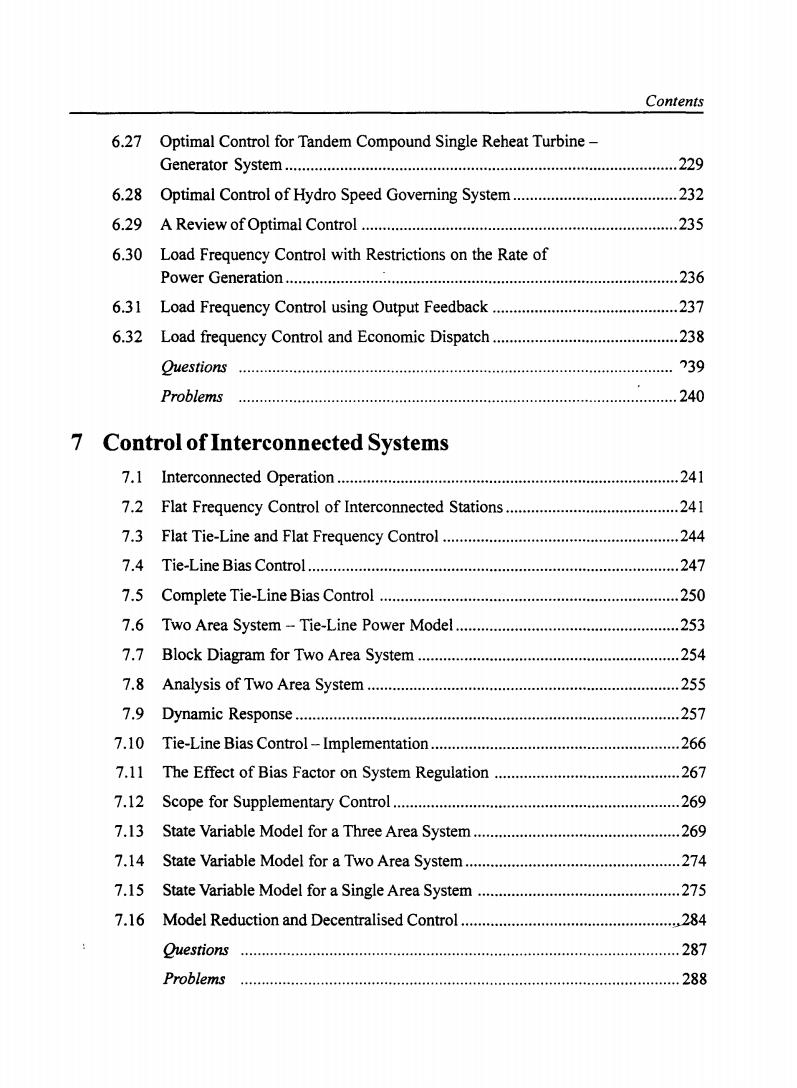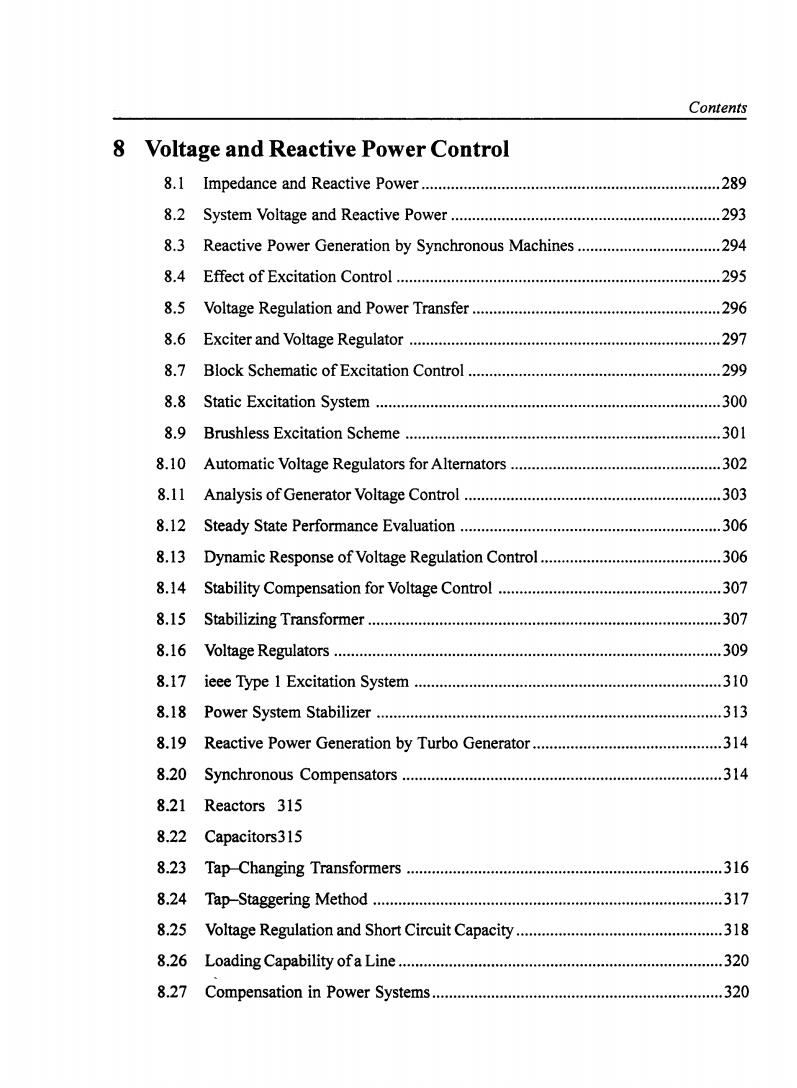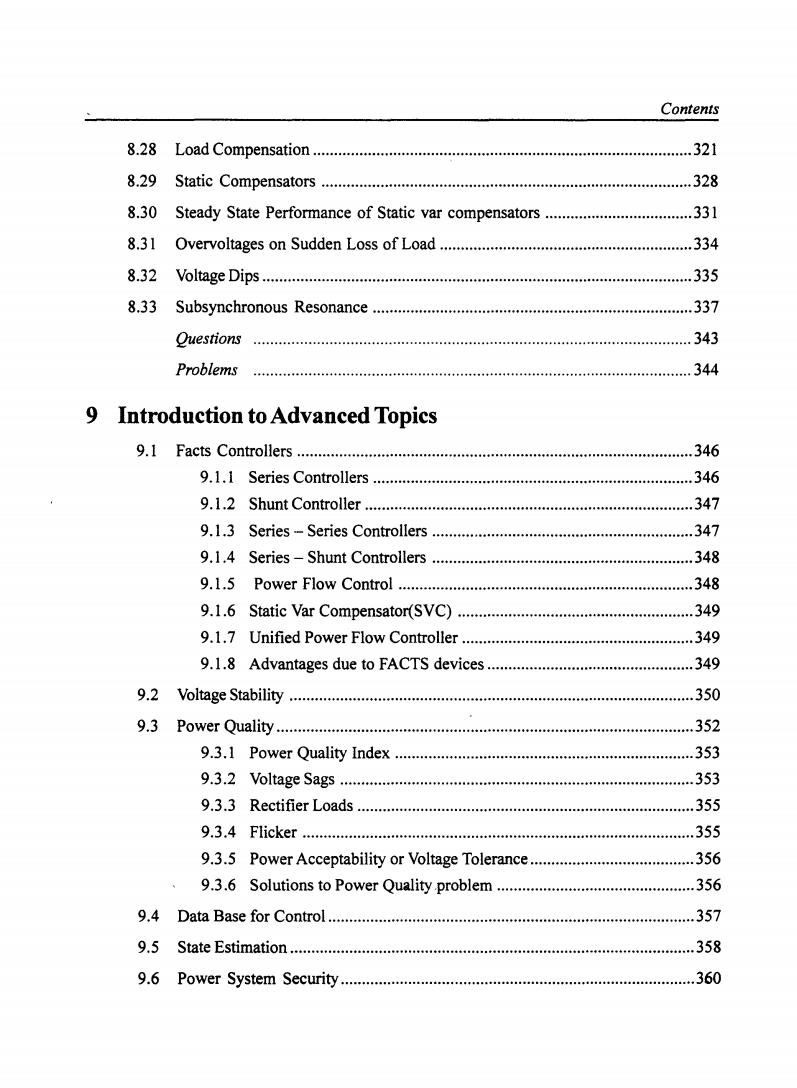
Contents 6.27 Optimal Control for Tandem Compound Single Reheat Turbine- Generator System........... …229 6.28 Optimal Control of Hydro Speed Governing System.....32 6.29 A Review of Optimal Control ......... .235 6.30 Load Frequency Control with Restrictions on the Rate of Power Generation… …236 6.31 Load Frequency Control using Output Feedback.... 237 6.32 Load frequency Control and Economic Dispatch... 238 2 uestions… 39 Problems…. ..240 7 Control of Interconnected Systems 7.1 Interconnected Operation................ …241 7.2 Flat Frequency Control of Interconnected Stations....... ..241 7.3 Flat Tie-Line and Flat Frequency Control........... …244 7.4 Tie-Line Bias Control........... …247 7.5 Complete Tie-Line Bias Control ......... .250 7.6 Two Area System-Tie-Line Power Model.... 253 7.7 Block Diagram for Two Area System.......... 254 7.8 Analysis of Two Area System ........ 255 7.9 Dynamic Response… 257 7.10 Tie-Line Bias Control-Implementation................. .266 7.11 The Effect of Bias Factor on System Regulation ........... 267 7.12 Scope for Supplementary Control....... 269 7.13 State Variable Model for a Three Area System....... .269 7.14 State Variable Model for a Two Area System..... .274 7.15 State Variable Model for a Single Area System...... .275 7.16 Model Reduction and Decentralised Control... 284 Questions .287 Problems …288
Contents 6.27 Optimal Control for Tandem Compound Single Reheat Turbine - Generator System ............................................................................................. 229 6.28 Optimal Control of Hydro Speed Governing System ....................................... 232 6.29 A Review of Optimal Control ........................................................................... 235 6.30 Load Frequency Control with Restrictions on the Rate of Power Generation '" .................... : ..................................................................... 236 6.31 Load Frequency Control using Output Feedback ............................................ 237 6.32 Load frequency Control and Economic Dispatch ............................................ 238 Questions ....................................................................................................... "39 Problems ........................................................................................................ 240 7 Control of Interconnected Systems 7. 1 Interconnected Operation ................................................................................. 241 7.2 Flat Frequency Control of Interconnected Stations ......................................... 241 7.3 Flat Tie-Line and Flat Frequency Control ........................................................ 244 7.4 Tie-Line Bias Control ........................................................................................ 247 7.5 Complete Tie-Line Bias Control ....................................................................... 250 7.6 Two Area System - Tie-Line Power Model ..................................................... 253 7.7 Block Diagram for Two Area System .............................................................. 254 7.8 Analysis of Two Area System .......................................................................... 255 7.9 Dynamic Response ........................................................................................... 257 7.10 Tie-Line Bias Control- Implementation ........................................................... 266 7.11 The Effect of Bias Factor on System Regulation ............................................ 267 7.12 Scope for Supplementary Control .................................................................... 269 7.13 State Variable Model for a Three Area System ................................................. 269 7.14 State Variable Model for a Two Area System ................................................... 274 7.15 State Variable Model for a Single Area System ................................................ 275 7.16 Model Reduction and Decentralised Control .................................................. ,284 Questions ........................................................................................................ 287 Problems ........................................................................................................ 288

Contents 8 Voltage and Reactive Power Control 8.1 Impedance and Reactive Power......... .289 8.2 System Voltage and Reactive Power........... …293 8.3 Reactive Power Generation by Synchronous Machines94 8.4 Effect of Excitation Control........ 295 8.5 Voltage Regulation and Power Transfer ........ …296 8.6 Exciter and Voltage Regulator ... …297 8.7 Block Schematic of Excitation Control....... .299 8.8 Static Excitation System ............. 300 8.9 Brushless Excitation Scheme .................. 301 8.10 Automatic Voltage Regulators for Alternators.... 302 8.11 Analysis of Generator Voltage Control.. 303 8.12 Steady State Performance Evaluation....... .306 8.13 Dynamic Response of Voltage Regulation Control.... 306 8.14 Stability Compensation for Voltage Control ... .…307 8.15 Stabilizing Transformer....... 307 8.16 Voltage Regulators .309 8.17 ieee Type 1 Excitation System ..... 310 8.18 Power System Stabilizer... 313 8.19 Reactive Power Generation by Turbo Generator...... 314 8.20 Synchronous Compensators..... 314 8.21 Reactors 315 8.22 Capacitors315 8.23 Tap-Changing Transformers . 316 8.24 Tap-Staggering Method..... 317 8.25 Voltage Regulation and Short Circuit Capacity.......... 318 8.26 Loading Capability ofa Line.... …320 8.27 Compensation in Power Systems.... 320
(XVl) Contents 8 Voltage and Reactive Power Control 8.1 Impedance and Reactive Power ....................................................................... 289 8.2 System Voltage and Reactive Power ................................................................ 293 8.3 Reactive Power Generation by Synchronous Machines .................................. 294 8.4 Effect of Excitation Control ............................................................................. 295 8.5 Voltage Regulation and Power Transfer ........................................................... 296 8.6 Exciter and Voltage Regulator .......................................................................... 297 8.7 Block Schematic of Excitation Control ............................................................ 299 8.8 Static Excitation System .................................................................................. 300 8.9 Brushless Excitation Scheme ........................................................................... 301 8.10 Automatic Voltage Regulators for Alternators .................................................. 302 8.11 Analysis of Generator Voltage Control ............................................................. 303 8.12 Steady State Performance Evaluation .............................................................. 306 8.13 Dynamic Response of Voltage Regulation Control ........................................... 306 8.14 Stability Compensation for Voltage Control ..................................................... 307 8.15 Stabilizing Transformer .................................................................................... 307 8.16 Voltage Regulators ............................................................................................ 309 8.17 ieee Type 1 Excitation System ......................................................................... 310 8.18 Power System Stabilizer .................................................................................. 313 8.19 Reactive Power Generation by Turbo Generator ............................................. 314 8.20 Synchronous Compensators ............................................................................ 314 8.21 Reactors 315 8.22 Capacitors315 8.23 Tap---Changing Transformers ........................................................................... 316 8.24 Tap-Staggering Method ................................................................................... 317 8.25 Voltage Regulation and Short Circuit Capacity ................................................. 318 8.26 Loading Capability of a Line ............................................................................. 320 8.27 Compensation in Power Systems ..................................................................... 320

Contents 8.28 Load Compensation.. 321 8.29 Static Compensators. 328 8.30 Steady State Performance of Static var compensators...... .331 8.31 Overvoltages on Sudden Loss of Load....... .334 8.32 Voltage Dips… .335 8.33 Subsynchronous Resonance ......... .337 Questions 343 Problems .344 9 Introduction to Advanced Topics 9.1 Facts Controllers...... .346 9.1.1 Series Controllers..346 9.1.2 Shunt Controler.347 9.1.3 Series-Series Controllers..347 9.1.4 Series-Shunt Controllers .......... .348 9.1.5 Power Flow Control .......... ..348 9.1.6 Static Var Compensator(SVC)........ …349 9.1.7 Unified Power Flow Controller...... .349 9.1.8 Advantages due to FACTS devices …349 9.2 Voltage Stability .350 9.3 Power Quality.… 352 9.3.1 Power Quality Index..... .353 9.3.2 Voltage Sags… .353 9.3.3 Rectifier Loads 355 9.3.4 Flicker… .355 9.3.5 Power Acceptability or Voltage Tolerance.356 、 9.3.6 Solutions to Power Quality problem356 9.4 Data Base for Control..... 357 9.5 State Estimation............ 358 9.6 Power System Security.... ..360
(xviI) Contents 8.28 Load Compensation .......................................................................................... 321 8.29 Static Compensators ........................................................................................ 328 8.30 Steady State Perfonnance of Static var compensators ................................... 331 8.31 Overvoltages on Sudden Loss of Load ............................................................ 334 8.32 Voltage Dips ...................................................................................................... 335 8.33 Subsynchronous Resonance ............................................................................ 337 Questions ........................................................................................................ 343 Problems ........................................................................................................ 344 9 Introduction to Advanced Topics 9.1 Facts Controllers .............................................................................................. 346 9.1.1 Series Controllers ............................................................................ 346 9.1.2 Shunt Controller .............................................................................. 347 9.1.3 Series - Series Controllers .............................................................. 347 9.1.4 Series - Shunt Controllers .............................................................. 348 9.1.5 Power Flow Control ...................................................................... 348 9.1.6 Static Var Compensator(SVC) ........................................................ 349 9.1.7 Unified Power Flow Controller ....................................................... 349 9.1.8 Advantages due to FACTS devices ................................................. 349 9.2 Voltage Stability ................................................................................................ 350 9.3 Power Quality ................................................................................................... 352 9.3.1 Power Quality Index ....................................................................... 353 9.3.2 Voltage Sags .................................................................................... 353 9.3.3 Rectifier Loads ................................................................................ 355 9.3.4 Flicker ............................................................................................. 355 9.3.5 Power Acceptability or Voltage Tolerance ....................................... 356 9.3.6 Solutions to Power Quality.problem ............................................... 356 9.4 Data Base for Control ....................................................................................... 357 9.5 State Estimation ................................................................................................ 358 9.6 Power System Security .................................................................................... 360

Contents 9.7 Steady State Security Assessment .......... 361 9.8 Application to Outage Studies....... .362 9.9 Pattern Recognition Methods ......... 363 9.10 Power System Control Centres...... 365 9.11 Level Decomposition in Power Systems...... 367 9.12 Network Automation368 9.l3 LoadPrediction… .369 9.14 Load Prediction using Matereological Data............ 371 9.15 Spetral Expansion Method............. 376 9.16 Prediction by Scaling a Standard Load.... .377 9.17 Short-Term Load Forecasting Using Exponential Smoothing.... .378 9.18 Peak Power Demand Prediction......... .378 9.19 State Estimation in Load Forecasting379 9.20 Generating Capacity Reliability and Outage Probabilities.. .380 Questions .386 Objective Questions. 387 Answers to Objective Questions... 400 References.......... 401 Index 407 X0.4
(xviii) Contents 9.7 Steady State Security Assessment ................................................................... 361 9.8 Application to Outage Studies .......................................................................... 362 9.9 Pattern Recognition Methods ........................................................................... 363 9.10 Power System Control Centres ........................................................................ 365 9.11 Level Decomposition in Power Systems ......................................................... 367 9.12 NetworkAutomation ........................................................................................ 368 9.13 LoadPrediction ................................................................................................. 369 9.14 Load Prediction using Matereological Data ...................................................... 371 9.15 Spetral Expansion Method ................................................................................ 376 9.16 Prediction by Scaling a Standard Load .......................................................... 377 9.17 Short - Term Load Forecasting Using Exponential Smoothing ....................... 378 9.18 Peak Power Demand Prediction ....................................................................... 378 9.19 State Estimation in Load Forecasting ............................................................... 379 9.20 Generating Capacity Reliability and Outage Probabilities ................................. 380 Questions ........................................................................................................ 386 Objective Questions .......................................................................... 387 Answers to Objective Questions ...................................................... 400 References ......................................................................................... 401 Index ................................................................................................. 407

1 INTRODUCTION Elecrical energy is the most popular form of energy,because it can be transported easily at high efficiency and reasonable costs.Thomas Edison,established the first power station in 1882 at New York city,United States of America.The lower Manhattan area was supplied DC power from this station.Underground cables were used for distribution.At Appelton,Wisconcin the first water wheel generator was installed.Under Edison's patents several companies started functioning in USA.However,these companies could supply energy to small distances due to 12R power loss being excessive at low voltage distribution. In 1885,Willliam Stanley invented the transformer.which revolutionized the AC transmission.The invention of induction motor in 1888 by Nnikola Tesla caused dramatic change in electrical power consumption through AC replacing many DC motor loads. It is now an acknowledged fact that HV and EHV transmission alone can reduce substantially the losses and bulk power transmission is feasible at these voltages.Nevertheless, it is also well established that HVDC is convenient and more economical from operation and control point of view under certain circumstances such as at distances of more than 500 kms. A detailed discussion of this aspect is not within the purview of this book. In India,two third of the electrical power generated is from coal based power stations. Of the rest,about 24%comes from hydroelectric,8.7%from Gas fired plants,2.4%from nuclear power plants.At the time of independence,the per capita consumption of electric
1 INTRODUCTION Elecrical energy is the most popular form of energy, because it can be transported easily at high efficiency and reasonable costs. Thomas Edison, established the first power station in 1882 at New York city, United States of America. The lower Manhattan area was supplied DC power from this station. Underground cables were used for distribution. At Appelton, Wisconcin the first water wheel generator was installed. Under Edison's patents several companies started functioning in USA. However, these companies could supply energy to small distances due to I2R power loss being excessive at low voltage distribution. In 1885, Wililiam Stanley invented the transformer. which revolutionized the AC transmission. The invention of induction motor in 1888 by Nnikola Tesla caused dramatic change in electrical power consumption through AC replacing many DC motor loads. It is now an acknowledged fact that HV and EHV transmission alone can reduce substantially the losses and bulk power transmission is feasible at these voltages. Nevertheless, it is also well established that HVDC is convenient and more economical from operation and control point of view under certain circumstances such as at distances of more than 500 kms. A detailed discussion of this aspect is not within the purview of this book. In India, two third of the electrical power generated is from coal based power stations. Of the rest, about 24% comes from hydroelectric, 8.7% from Gas fired plants, 2.4% from nuclear power plants. At the time of independence, the per capita consumption of electric